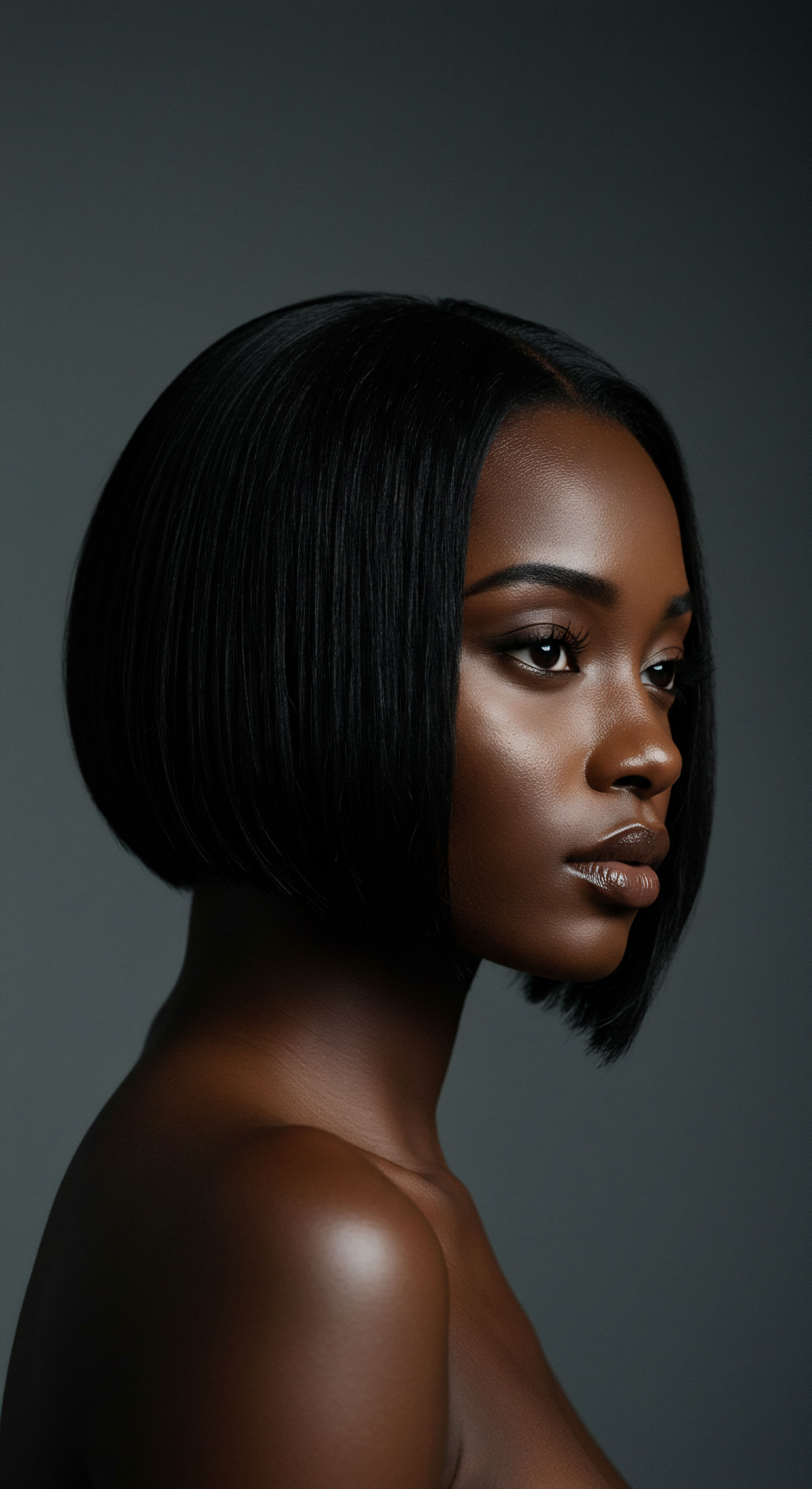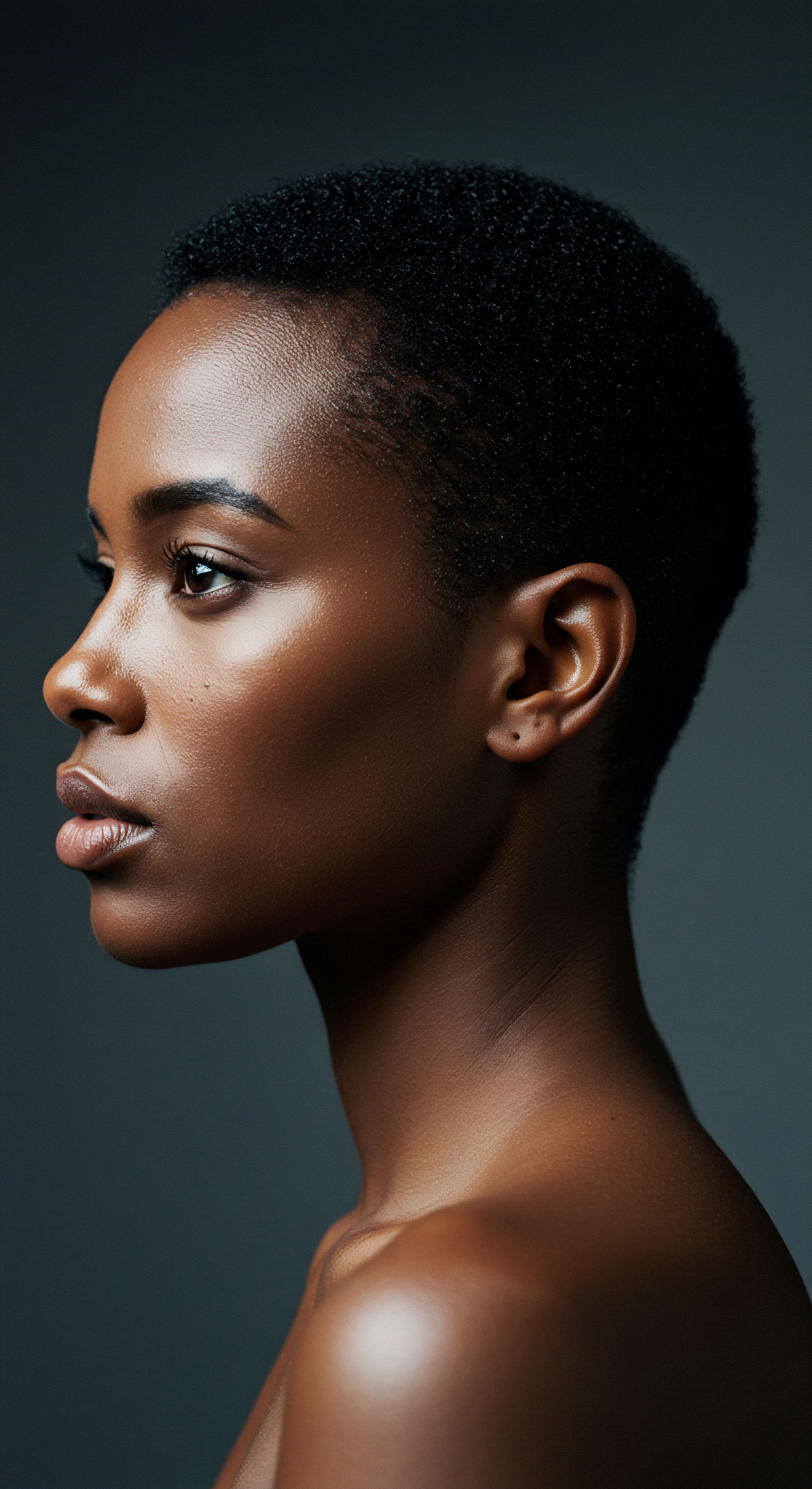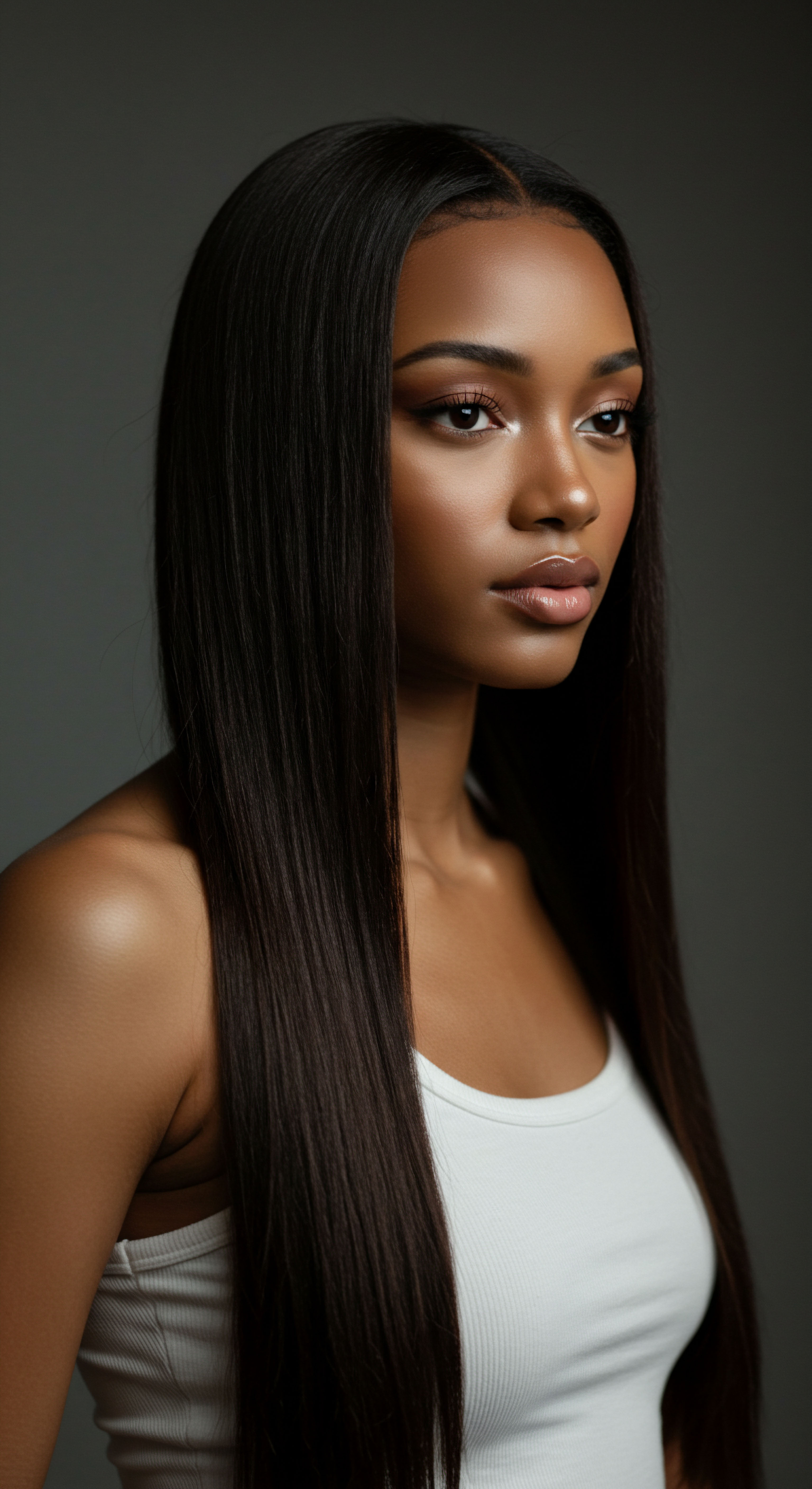
Roots
The water that graces our homes, the very liquid we rely upon for cleansing, holds within its clear depths an unseen complexity. For those with textured hair, this complexity often translates into a silent, persistent challenge. We speak of hard water, a common phenomenon across many regions, defined by its elevated concentration of dissolved minerals. These minerals, primarily calcium and magnesium, embark on a quiet journey from the earth, through our pipes, and directly onto our hair.
Their arrival is not always benign; instead, they cling, creating a unique interaction with our strands that can reshape the daily experience of hair care. Understanding this fundamental connection, the very elemental bond between water’s mineral content and our hair’s structure, provides a grounding presence in the often-perplexing world of textured hair wellness.

What Constitutes Hard Water?
Water’s hardness is a measurement of its mineral content, specifically the presence of divalent ions such as calcium (Ca2+) and magnesium (Mg2+). These ions are picked up as water travels through geological formations, dissolving soluble mineral compounds. The United States Geological Survey (USGS) offers a classification system for water hardness, categorizing it from soft to very hard based on the concentration of calcium carbonate. A water sample with a calcium carbonate level exceeding 180 milligrams per liter is considered very hard.
Hard water, characterized by its elevated mineral content, primarily calcium and magnesium, interacts with hair on a fundamental level, influencing its appearance and feel.
The presence of these minerals is often visible in our homes as limescale deposits on faucets and showerheads, or as a reduced lather from soaps. On hair, this interaction is more subtle, yet its effects are quite real. The mineral ions carry a positive electrical charge, making them cations.
Our hair, particularly its outermost layer, the cuticle, often carries a negative charge. This difference in electrical potential creates an attraction, allowing these mineral cations to adhere to the hair shaft.

How Hair’s Surface Attracts Minerals
The hair shaft, a complex protein structure, presents an inviting surface for these mineral ions. The outermost layer, the cuticle, comprises overlapping scales. When hair is healthy and undisturbed, these scales lie relatively flat, creating a smooth surface. However, various factors, including the act of washing itself, can cause these cuticle scales to lift.
Once lifted, the underlying protein structures of the hair become more exposed, revealing negatively charged sites. These anionic sites act as magnets for the positively charged calcium and magnesium ions present in hard water.
This electrostatic attraction is a primary mechanism by which hard water minerals attach to hair. It is a similar principle to how some conditioning agents, which are also cationic, bond to the hair to smooth the cuticle. However, while conditioners are designed to provide a beneficial, temporary coating, hard water minerals can accumulate, creating a less desirable film.
This mineral accumulation is more pronounced on hair that has experienced prior damage. Chemically processed hair, such as bleached or color-treated strands, exhibits an increased negative charge on its surface, making it even more susceptible to mineral binding.
- Calcium Ions are particularly adept at penetrating the hair fiber, settling primarily within the cuticle layers, especially where damage exists.
- Magnesium Ions also deposit on the hair surface, contributing to the overall mineral load.
- Hair Porosity also plays a significant role, with higher porosity hair, which has more open cuticles, tending to accumulate more hard water deposits.

Ritual
Stepping into the daily or weekly rhythm of hair care, many of us encounter the silent influence of hard water. The ritual of washing, conditioning, and styling, meant to bring vitality to our strands, can inadvertently become a repeated invitation for minerals to settle. This section delves into the tangible ways hard water minerals manifest on hair, shifting from the foundational understanding to the practical implications and the practices that can gently guide our hair back to its desired state.

Recognizing Mineral Presence on Hair
The attachment of hard water minerals often reveals itself through a collection of subtle yet persistent signs. Hair might begin to feel rough or coarse to the touch, losing its customary softness. A lack of shine, a dullness that seems to cling despite diligent conditioning, can also point to mineral buildup. For those with textured hair, this can mean a loss of curl definition, a feeling of persistent dryness, or an unexpected stiffness that resists styling.
The minerals, especially calcium, can react with the natural oils produced by the scalp, creating a sticky residue that weighs down the hair and diminishes its inherent luster. This interaction can also affect how well cleansing products lather, requiring more shampoo to achieve a satisfactory cleanse. Over time, this continuous mineral deposition can lead to a cycle where hair feels perpetually unclean, even after washing.

How Hard Water Minerals Impact Hair Health
The presence of these mineral deposits can impede the hair’s ability to absorb moisture. A film of calcium and magnesium on the hair shaft can act as a barrier, preventing hydrating ingredients from reaching the inner cortex. This moisture blockage leads to dehydration, making strands more prone to dryness and breakage.
Moreover, the interaction between minerals and hair proteins can lead to increased stiffness. Calcium, for instance, can react with the protein structure of hair fibers, causing them to become rigid. This stiffness can make hair more susceptible to breakage during everyday manipulation, such as detangling or styling. Color-treated hair faces an additional challenge; hard water minerals can interact with hair dye chemicals, potentially distorting the color and accelerating fading.
| Hair Characteristic Texture |
| Manifestation Roughness, coarseness, or a sticky feel. |
| Hair Characteristic Appearance |
| Manifestation Dullness, lack of shine, or a film-like coating. |
| Hair Characteristic Manageability |
| Manifestation Increased tangling, difficulty detangling, or resistance to styling. |
| Hair Characteristic Moisture |
| Manifestation Persistent dryness, even after moisturizing, or reduced product absorption. |
| Hair Characteristic Scalp Health |
| Manifestation Dryness, flakiness, or itchiness due to mineral residue. |

Practical Approaches to Mitigation
Addressing hard water mineral attachment often begins with a thoughtful approach to washing. Incorporating chelating shampoos into a hair care regimen can be particularly helpful. These specialized cleansers contain agents that bind to mineral ions, forming a complex that can be rinsed away more readily. Such products effectively remove accumulated deposits without stripping the hair’s natural oils.
Regular use of chelating agents helps dislodge mineral deposits, allowing hair to reclaim its softness and absorb moisture more effectively.
For some, a simple apple cider vinegar rinse offers a gentle, acidic alternative. The low pH of vinegar can assist in loosening mineral bonds and smoothing the cuticle, making hair feel softer and more manageable. While effective for some, the consistency of results can vary.
Ultimately, the most comprehensive approach to mitigating hard water’s effects involves addressing the water source itself. Installing a shower filter can reduce the concentration of minerals reaching the hair during washing. For a more complete solution, a whole-house water softening system removes minerals from all water entering the home, offering consistent relief for both hair and skin.
- Chelating Shampoos contain specific ingredients that cage mineral particles, enabling their removal during rinsing.
- Apple Cider Vinegar Rinses offer an acidic alternative that can help dissolve some mineral buildup.
- Shower Filters act as a first line of defense, reducing mineral exposure at the point of contact with hair.

Relay
Beyond the visible signs and daily routines, the attachment of hard water minerals to hair extends into a realm of deeper scientific inquiry and subtle cultural interactions. This section transcends surface-level discussions, delving into the intricate molecular dance that binds these elements to our strands, the nuanced impacts on diverse hair types, and the broader context of water quality in hair wellness traditions. We explore the scientific underpinnings with precision, supported by research, to illuminate the complexities that often go unnoticed.

The Molecular Adhesion Process
At a microscopic level, the attachment of hard water minerals to hair is a process rooted in electrochemical principles. Hair keratin, the primary protein component of hair, contains various functional groups, including carboxylates, which carry a negative charge. Calcium (Ca2+) and magnesium (Mg2+) ions, being positively charged divalent cations, are naturally drawn to these anionic sites on the hair fiber. This electrostatic attraction forms ionic bonds, allowing the minerals to adhere firmly to the hair’s surface and even penetrate its inner layers.
The extent of this mineral uptake is directly influenced by the hair’s condition. Damaged hair, whether from chemical treatments like bleaching or coloring, or from mechanical stress, exhibits a higher density of negatively charged sites. This makes compromised hair more susceptible to mineral binding, leading to a greater accumulation of deposits.
Research indicates that bleached hair, for example, shows significantly higher metal content compared to virgin hair. The pH of the water also plays a role; alkaline water, with a higher pH, tends to increase the binding of metals to hair by increasing the number of negatively charged sites on the hair.
Hair’s negative surface charge creates an electrochemical affinity for positively charged hard water minerals, particularly intensified in damaged strands.

Impact on Hair Integrity and Health
The continuous deposition of these minerals can have a cascade of effects on hair integrity. Beyond the aesthetic changes like dullness and stiffness, the physical presence of mineral layers can hinder the hair’s natural functions. They can obstruct the cuticle, making it difficult for moisturizing agents to penetrate and nourish the hair cortex, leading to chronic dehydration. This can manifest as increased brittleness and a propensity for breakage, especially for textured hair types that already require diligent moisture retention.
A study published in the International Journal of Trichology in 2016, involving 70 male participants, demonstrated a significant reduction in the tensile strength of hair samples treated with hard water compared to those treated with deionized water. This suggests that while hard water might not directly cause hair loss, it can weaken the hair shaft, making it more vulnerable to mechanical stress and breakage, which in turn can lead to perceived thinning or loss over time. The study found an average tensile strength of 234.16 N/mm² for hard water-treated hair versus 254.84 N/mm² for deionized water-treated hair, a quantifiable difference in the hair’s resistance to breaking under tension. This finding underscores the subtle yet impactful weakening hard water can impose on hair’s structural resilience.

Do Minerals Affect Hair Porosity?
The concept of hair porosity, referring to the hair’s ability to absorb and retain moisture, is deeply intertwined with mineral deposition. Hair with low porosity has tightly closed cuticles, naturally resisting moisture absorption. However, hard water minerals can create a barrier on the hair shaft, further impeding moisture penetration, even for hair that might not inherently be low porosity.
This can lead to hair that is drier, stiffer, and less elastic, mimicking the characteristics often attributed to low porosity hair. Conversely, high porosity hair, with its more open cuticle, is particularly susceptible to mineral buildup, as it readily absorbs substances from its environment.

Water Quality and Cultural Hair Traditions
Across diverse cultures, hair care practices have long adapted to local water conditions, even if the underlying science was not explicitly articulated. Traditional methods often involved ingredients that, in retrospect, possessed natural chelating or acidic properties. For instance, various plant-based rinses or fermented solutions used in historical hair rituals may have inadvertently helped to mitigate mineral buildup.
The understanding of water’s impact on hair is thus not merely a modern scientific discovery but a long-held, intuitively recognized truth woven into ancestral knowledge. This deep connection between environmental elements and hair health highlights a continuity in human efforts to care for their strands.
The challenge of hard water is a shared experience across many geographies. Hair mineral analysis, a laboratory screening test, can quantify the trace element and mineral content in hair samples, offering insights into long-term exposure to various elements, including those found in hard water. While not a diagnostic tool for hard water damage directly, it provides a snapshot of mineral accumulation within the hair over several months.
The table below illustrates the impact of different mineral ions often found in hard water on hair.
| Mineral Ion Calcium (Ca2+) |
| Primary Effect on Hair Forms insoluble salts, leading to dullness, stiffness, and reduced lather. |
| Additional Considerations Can penetrate hair fiber, especially damaged areas, and react with proteins. |
| Mineral Ion Magnesium (Mg2+) |
| Primary Effect on Hair Contributes to film-like residue, dryness, and weight. |
| Additional Considerations May show higher deposition than calcium in some studies, though its structural impact is debated. |
| Mineral Ion Iron (Fe3+) |
| Primary Effect on Hair Can cause discoloration, particularly in lighter or chemically treated hair. |
| Additional Considerations Often present in well water; can lead to reddish or orange tones. |
| Mineral Ion Copper (Cu2+) |
| Primary Effect on Hair May lead to green discoloration, especially in blonde hair, and interfere with chemical services. |
| Additional Considerations Highly affinitive for hair proteins, even at low concentrations. |
Understanding the specific roles of these ions allows for more targeted interventions, moving beyond generic solutions to address the precise chemical interactions occurring on and within the hair fiber. This deeper understanding empowers individuals to make informed choices about their hair care regimen and environmental adaptations.

Reflection
The unseen currents within our water, laden with the earth’s offerings, continually shape the very essence of our hair. The interaction between hard water minerals and textured strands is a testament to the profound connection between our environment and our personal well-being. It is a subtle dance of chemistry and care, inviting us to approach our hair not as a separate entity, but as a responsive part of our whole. By recognizing these mineral attachments, understanding their subtle influence, and thoughtfully adapting our rituals, we honor the resilience of our hair, allowing its inherent beauty to shine forth, unburdened by the unseen weight of the world’s waters.

References
- Al-Khateeb, E. & Al-Zoubi, Z. (2016). Effect of Hard Water on Hair. International Journal of Trichology, 8(3), 118-121.
- Al-Khateeb, E. Al-Zoubi, Z. & Abu-Halaweh, Z. (2017). Scanning electron microscopy study of hair shaft changes related to hardness of water. International Journal of Trichology, 9(3), 100-103.
- Cotton, D. W. K. et al. (1986). The effect of hard water on hair. Journal of the Society of Cosmetic Chemists, 37(1), 29-34.
- Evans, S. et al. (2011). The effect of water hardness on hair. Journal of Cosmetic Science, 62(5), 451-460.
- Garlapati, R. et al. (2013). To Evaluate and Compare Changes in Baseline Strength of Hairs after Treating them with Deionized Water and Hard Water and its Role in Hair Breakage. International Journal of Trichology, 5(2), 60-63.
- Luqman, M. et al. (2016). Effect of topical application of hard water in weakening of hair in men. International Journal of Trichology, 8(4), 163-166.
- Srinivasan, R. & Chakravarthy Rangachari, V. (2013). The effect of hard water on the tensile strength and elasticity of hair. International Journal of Trichology, 5(3), 119-122.
- Tamura, Y. et al. (2010). Effects of water hardness on hair and scalp. Journal of the Society of Cosmetic Chemists, 61(1), 1-10.
- Robbins, C. R. (2012). Chemical and Physical Behavior of Human Hair (5th ed.). Springer.
- Feughelman, M. (1997). Mechanical Properties of Hair. Marcel Dekker.
- Kostić, M. & Popović, A. (2014). Influence of water quality on hair properties. Textile Research Journal, 84(16), 1775-1783.
- Hotta, M. et al. (2007). Interaction of calcium ions with hair proteins. Journal of Cosmetic Science, 58(4), 355-364.
- Wallen, B. & Larsson, T. (1993). The effect of metal ions on the physical properties of hair. Journal of the Society of Cosmetic Chemists, 44(2), 85-92.
- McMullen, R. & Jachowicz, J. (2004). Conditioning Agents for Hair and Skin. CRC Press.
- Swift, J. A. (1999). The hair fibre ❉ its physical and chemical properties. International Journal of Cosmetic Science, 21(3), 159-170.